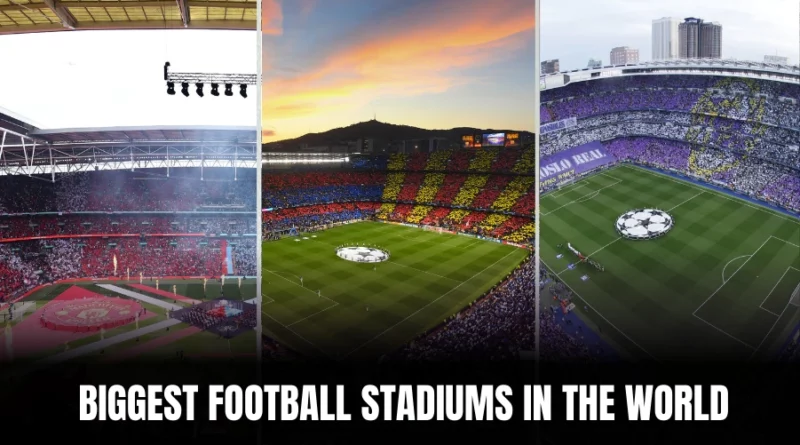Top 10 Biggest Football Stadiums in the World
In ancient Rome, gladiator fights used to be a common pastime for the public. Two warriors going head to head was a spectacle not to be missed. Fast forward to the modern day, and we have 22 gladiators taking on each other on the football field. They, too, deserve spectacular stadiums for the crowd to cheer them on. Keeping that in mind, let’s take a look at the biggest football stadium in the world, along with the top 10 based on capacity. For the sake of footballing purity, we are considering stadiums that are exclusively built for football.
Football is a global sport that draws huge crowds for every game taking place. National teams and clubs have realised the need for building state-of-the-art and modern stadiums with huge capacities. The capacity of a stadium plays a key role in making it a fortress for the home side. Imagine thousands of home crowd cheering their team together. From the 18th century, football stadiums have come a long way. In Recent times, with Manchester United announcing their plans for a new stadium with an increased capacity and Barcelona’s new stadium in progress, the question of the biggest football stadium in the world becomes quite relevant. Let us try to answer that question and also find out which other famous stadiums from around the world feature on this list.
List of the 10 Biggest Football Stadiums in the World
| Rank | Stadium Name | Capacity | Country |
|---|---|---|---|
| 10 | Estadio Mas Monumental | 84,567 | Argentina |
| 9 | Santiago Bernabeu | 85,000 | Spain |
| 8 | Borg El-Arab Stadium | 86,000 | Egypt |
| 7 | Bukit Jalil National Stadium | 87,411 | Malaysia |
| 6 | Estadio Azteca | 87,523 | Mexico |
| 5 | Lusail Stadium | 88,966 | Qatar |
| 4 | Wembley Stadium | 90,000 | England |
| 3 | New Administrative Capital Stadium | 93,940 | Egypt |
| 2 | FNB Stadium | 94,736 | South Africa |
| 1 | Camp Nou | 99,534 | Spain |
Top 10 Biggest Football Stadiums
The biggest football stadiums were built for different purposes. Some were built for special tournaments and occupied by national teams. Some were built keeping only club football in mind. For convenience’s sake, let us consider only the stadiums that were built exclusively for football. Let us take a look at the biggest stadium in the world, along with the top 10 biggest stadiums in the world.
10. Estadio Mas Monumental (Beunos Aires, Argentina)
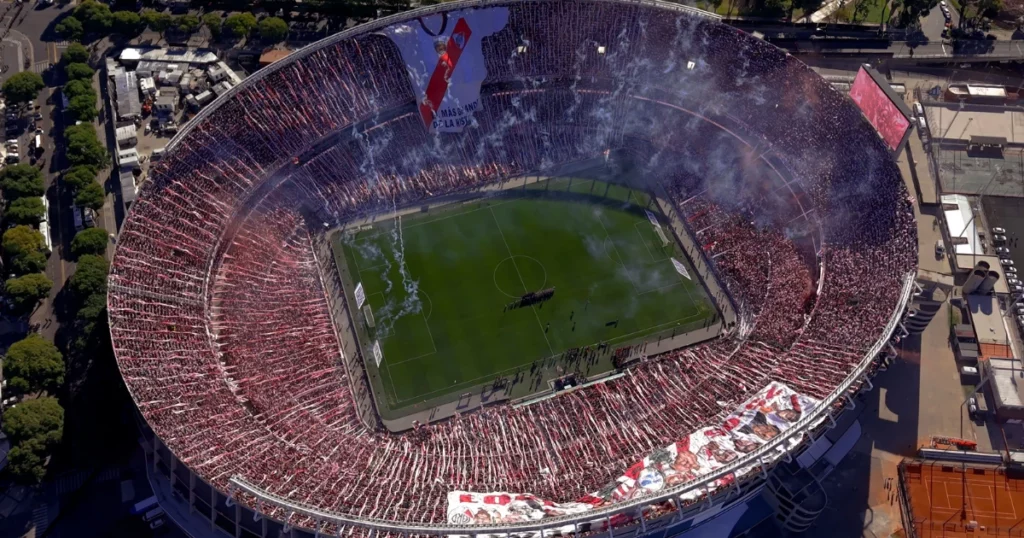
The Estadio Mas Monumental, located in Belgrano, is the largest stadium in South America. It is completely owned and operated by Club Atlético River Plate. The club, after seeing immense success, wanted to build a new stadium. They began the construction work in 1934 and opened it to the public in 1938. It was quite a costly venture at that time, as River Plate shelled out $3 million for the stadium. Estadio Mas Monumental also had an athletic track, making it fit to host track and field events.
The stadium had multiple renovations, most notably in 2020 when the athletic track was removed, and it was converted to a pure football stadium. However, the stadium’s compound has a massive upgrade as it has indoor basketball and volleyball courts, including state-of-the-art seating. Estadio Mas Monumental is home to River Plate and the Argentine national team. It hosted the 1978 FIFA World Cup along with four Copa America finals and multiple Copa Libertadores finals.
9. Santiago Bernabeu (Madrid, Spain)
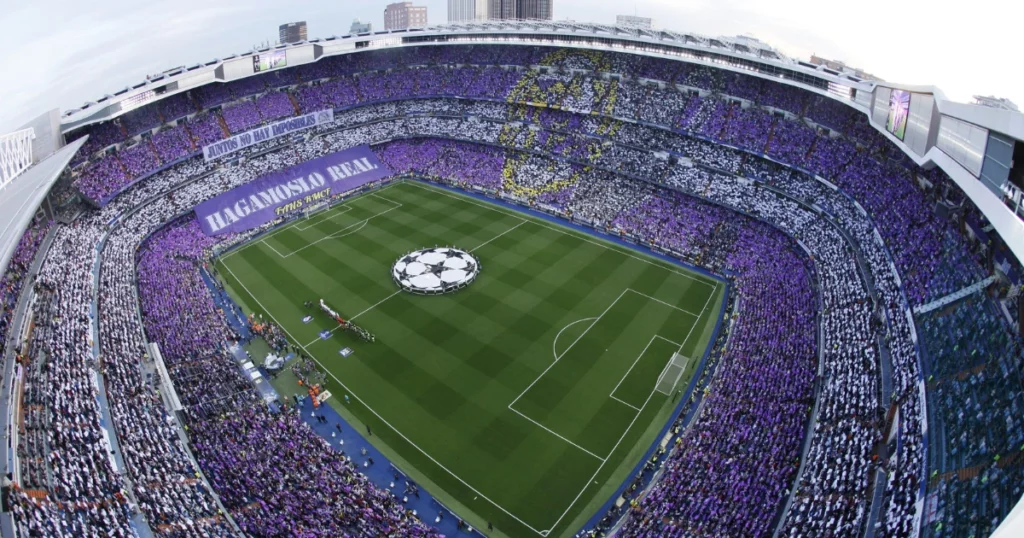
Estadio Santiago Bernabeu is one of the biggest stadiums in the world. It is also the home of one of the best football clubs in the world, Real Madrid. Right from its construction to renovation, Real Madrid had a role in everything related to the stadium. Real Madrid’s growing fame in the 1940s needed a new stadium to accommodate the huge crowds that turned up at the stadium. Santiago Bernabeu, the then-president of the club, was the visionary who did all the groundwork for the stadium. The stadium was named after Bernabeu in his honour after his passing.
Santiago Bernabeu used to be a leader in the stadium segment in the 1960s by adopting modern technologies. The next main steps in the history of this great stadium were taken thanks to the current president, Florentino Perez. Perez undertook a huge renovation project by completely reworking the stadium. They tore down the stadium and renovated it from scratch, and made it a symbol for the future. Bernabeu, with a capacity of 85,000, is a self-sustaining structure that is active on all days of the year. It is much more than a football stadium as it can host basketball events, esports, and private events.
Also Read: Top 10 Most Expensive Football Stadiums in the World: Ranked
8. Borg El-Arab Stadium (Amreya, Egypt)
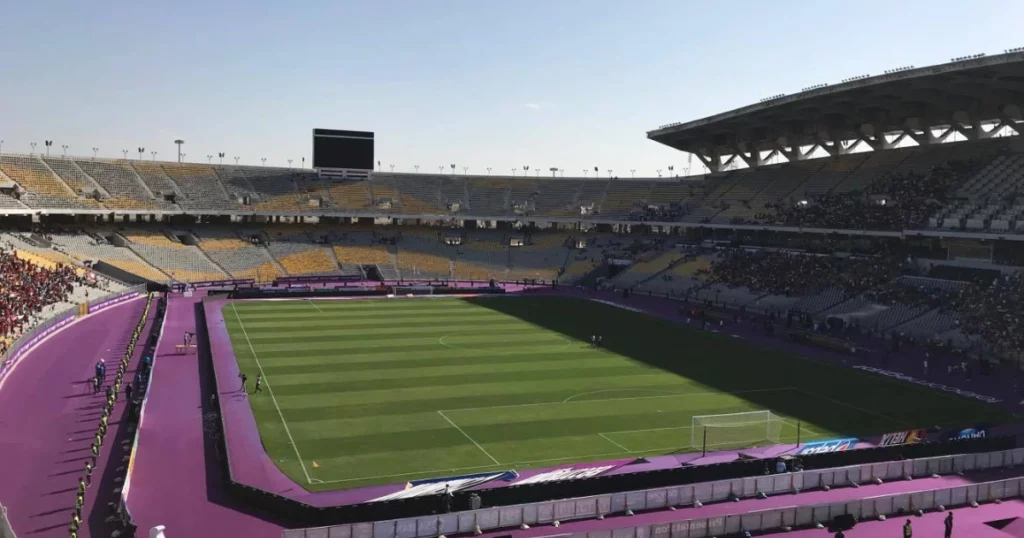
The stadium, referred to as the Egyptian Army Stadium or El Geish Stadium-Alexandria, used to be the home of the Egyptian national team till the Misr Stadium was completed. Borg El-Arab Stadium is located in the Mediterranean coastal city of Amreya, west of Alexandria, and was exclusively designed and constructed by the Egyptian Armed Forces. The stadium was one of the 5 international-standard stadiums built for Egypt’s bid for the 2010 FIFA World Cup.
However, as the bid failed, the Egyptian national team moved in to occupy the stadium. Alexandria-based Premier League side Smouha also used the stadium as its home. Since 2016, multiple top Egyptian clubs like Al Ahly, Al Ittihad, and Zamalek have played their key matches here thanks to its excellent features. FIFA awarded the 2009 FIFA U-20 World Cup to Egypt as a token of gratitude, and Borg El-Arab Stadium hosted the opening game of the tournament along with the opening ceremony. The stadium is completely air-conditioned to beat the heat and has excellent modern facilities.
7. Bukit Jalil National Stadium (Bukit Jalil, Malaysia)
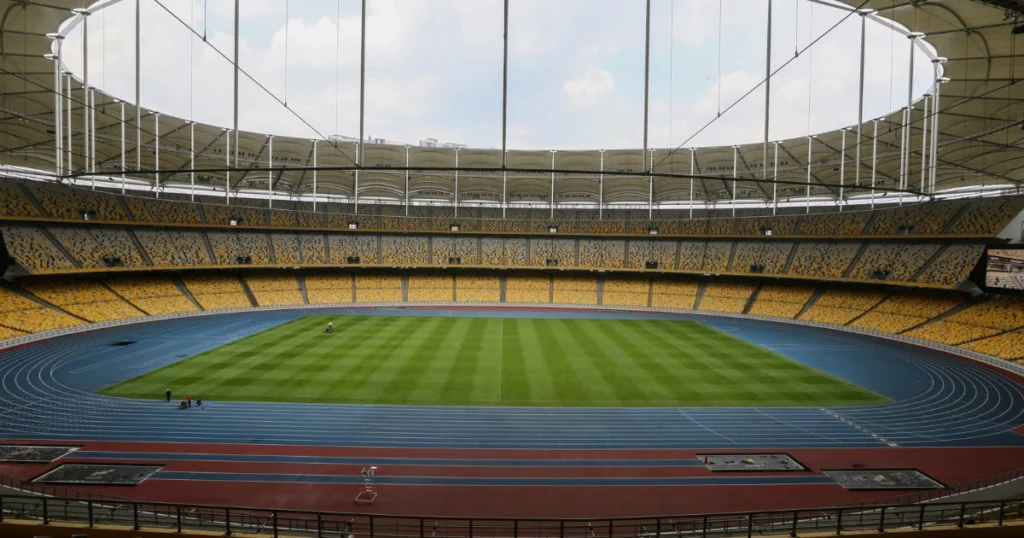
The Bukit Jalil National Stadium is the largest in Southeast Asia. It was officially inaugurated by ex-Malaysian Prime Minister Mahathir Mohamad in 1998 and was built for the 1998 Commonwealth Games, and also hosted its opening ceremony. After its completion, the stadium became the national sports venue of the country. Bukit Jalil National Stadium is the home of the Malaysian national football team and holds national-level competitions regularly.
The stadium was initially built to have a capacity of 100,000. It set back the country’s economy by RM 1 billion. A record crowd of 98,543 attended the game between Malaysia vs Indonesia. After security regulations and modern renovation, the capacity was reduced to just 90,000 in the stadium. However, only 87,411 are used currently. The stadium saw incredible turnouts for various concerts like Ed Sheeran’s, Coldplay, and Bruno Mars.
6. Estadio Azteca (Mexico City, Mexico)
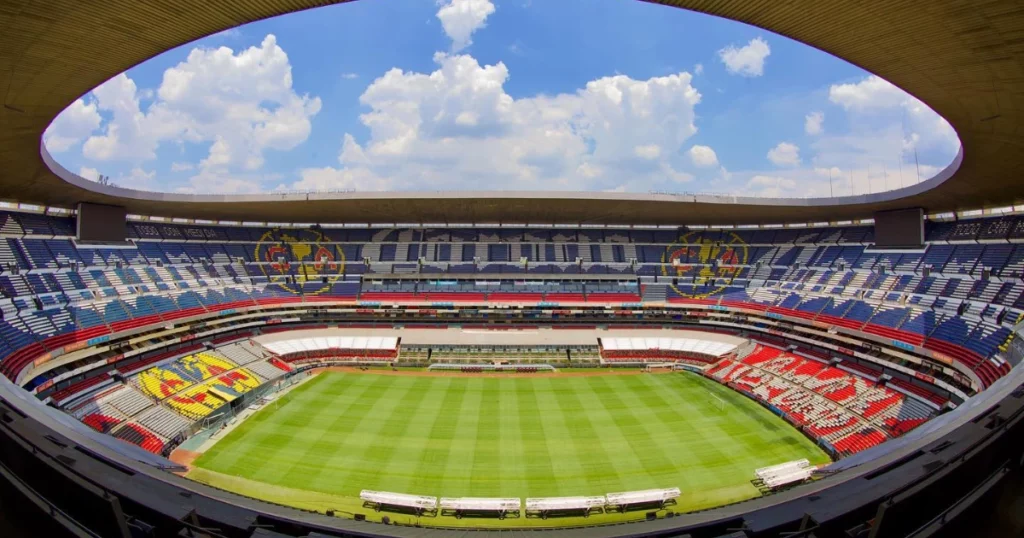
Estadio Azteca is the largest football stadium located in Latin America and one of the biggest football stadiums in the world. The construction of the stadium was commissioned in the early 1960s as the then-president Adolfo López Mateos wanted his country to be a major sports hub. It was set to be completed in time for the 1968 Summer Olympics. One of the first football games played at the venue drew a record crowd of 119,853 spectators. However, its recent capacity has decreased to the upper 80 thousand, keeping in line with the recent guidelines.
The stadium has a rich history as it is the first venue to host 2 World Cup finals. It hosted the “Game of the Century” in the 1970 World Cup, including the finals, and the “Goal of the Century” and “Hand of God Goal” in the 1986 World Cup, including the finals. It will create history when it hosts the opener of the 2026 FIFA World Cup by becoming the only stadium to host three World Cups. Estadio Azteca is currently home to the Mexican national football team and Club América. It is also a key venue for political events and concerts.
5. Lusail Stadium (Lusail, Qatar)
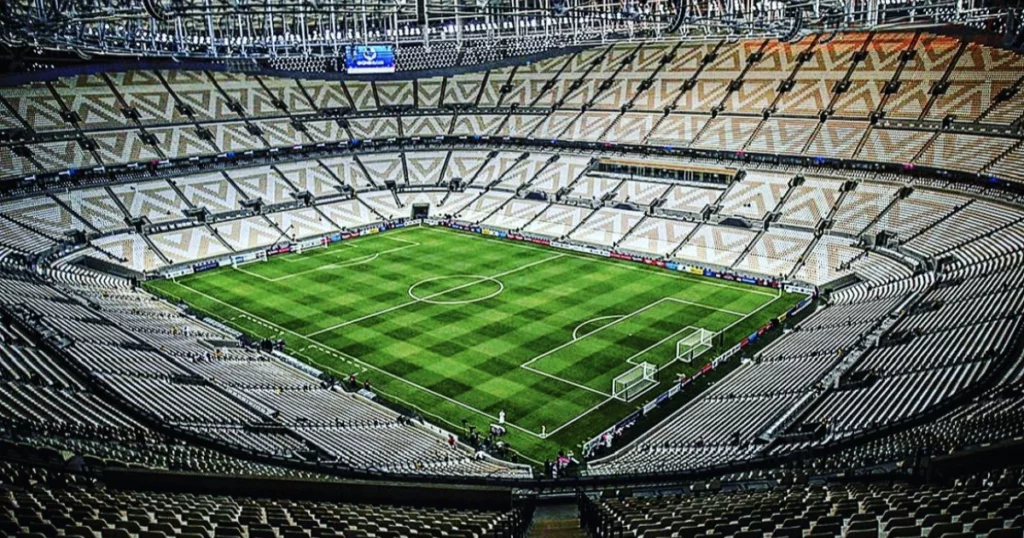
Qatar was a country completely dependent on fossil fuels for its revenue. They wanted to diversify their revenue stream and turned to sports, and caught the attention of the world when they were awarded the hosting rights of the 2022 FIFA World Cup. For a country with very little football infrastructure, it was a challenge to host such a once-in-a-lifetime event. The Crown of Qatar took it proudly and started building multiple state-of-the-art stadiums. Lusail Stadium was the beacon of the event as it hosted key games, including the final.
It was built in city coastal city of Lusail, north of Doha. They made it the largest stadium in the Middle East, and the stadium was powered by solar power and has a zero carbon footprint. Lusial Stadium resembles a huge bowl, which is a reference to the traditional vessel for dried dates. It was given a fantastic golden façade featuring triangular openings. The World Cup final was such a spectacular marvel between Argentina and France, and the stadium also found its uses after the World Cup.
Also Read: Parc des Princes: Capacity, Size, Events, Tickets and Legacy
4. Wembley Stadium (London, England)
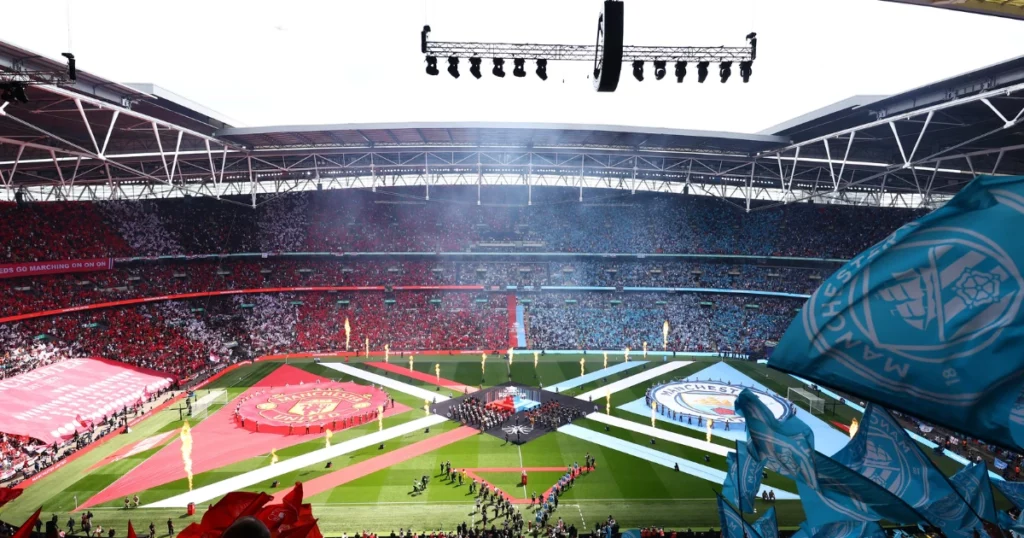
Often considered the Mecca of football by many around the world, Wembley is as iconic as a football stadium can be. The stadium, with over 100 years of history, has seen the epic highs and lows of the teams that played there. It is the home of the England men’s and women’s national teams and hosts the season opener and ending matches of every season in England. Wembley Stadium was built in 1923, keeping the British Empire Exhibition in mind in Wembley Park. The stadium became a massive hit during the exhibition and began hosting the FA Cup finals.
It eventually became the regular host of the stadium thanks to its huge capacity and iconic twin towers. It hosted the 1966 World Cup final along with the 1996 Euro final and glorified its lore. The stadium needed modernisation and underwent a complete reconstruction in 2003 at the same site. The New Wembley Stadium was opened to the public in 2007. It continued to be the home of the English national teams and is also an important venue for other events such as the NFL, rugby, and musical concerts.
3. New Administrative Capital Stadium (New Administrative Capital, Egypt)
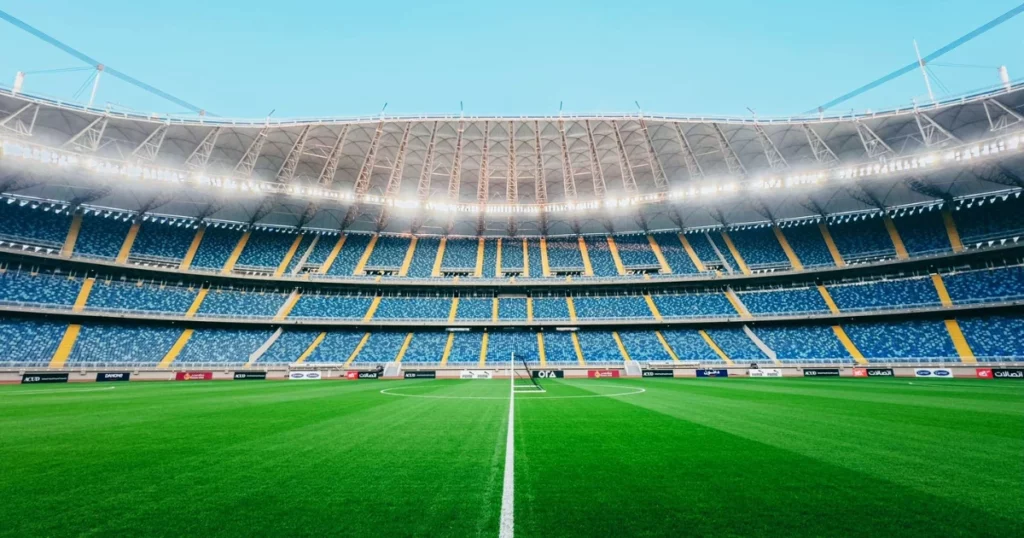
The Misr Stadium, commonly known as the New Administrative Capital Stadium, is a stadium in Egypt’s Olympic Sports City in the New Administrative Capital. Egypt plans to shift its capital from Cairo and is building a new world-class city. They wanted a football stadium to be its crown jewel while being able to host the Summer Olympics as well. Hence, the government of Egypt built the second-largest stadium in Africa as its centrepiece.
The Misr Stadium is built on an elliptical ground plan, while the roof design is based on the headdress and the royal necklace of Nefertiti, the ancient Egyptian queen. New Administrative Capital Stadium was completed in 2023 and hosted a couple of games of the Egyptian National Team. Egypt aims to bid and host the FIFA World Cup at this massive venue and the stadium was built with a view on hosting Atheltic events as well.
2. FNB Stadium (Johannesburg, South Africa)

The First National Bank Stadium, simply known as the FNB Stadium, is located in the picturesque city of Johannesburg. It is the home of Kaizer Chiefs. FNB Stadium was redesigned for the 2010 World Cup as its main attraction. Since a sponsorship name couldn’t be used for FIFA events, it was referred to as the Soccer City stadium and is also known as “The Calabash” due to its resemblance to the African Pot.
FNB Stadium was built in 1986 and is owned by the City of Johannesburg. It became an important iconic structure in South Africa, as many influential figures like Nelson Mandela used it for their speeches and events. The stadium hosted the African Cup of Nations in the 90s before undergoing a major overhaul before the 2010 World Cup. New tiers of seating were added, and capacity was increased. The stadium also plays host to domestic and international rugby matches. Chris Brown’s The 11:11 Tour saw a record crowd of 189,742 at the FNB Stadium.
1. Spotify Camp Nou (Barcelona, Spain)

The biggest football stadium in the world is the iconic home of FC Barcelona. The stadium is considered one of the most iconic in the world thanks to its design and the team’s legacy. Camp Nou hosted many legendary games, including the Champions League finals and FIFA World Cup games. Legendary Barcelona teams have graced this stadium and every blade of its grass has bathed in history. The trademark of this stadium was its cauldron-like shape with open terraces that are humongous.
Camp Nou was officially opened in 1957 and saw crowds of more than 100,000 regularly. However, due to safety constraints, the stadium was standardised, keeping in line with the Taylor report. After Real Madrid renovated their stadium, Barcelona followed suit by making similar plans. The renovated Spotify Camp Nou would have 100,000+ capacity again and would lead Barcelona into a new era. As the stadium is undergoing renovation currently, Barcelona are playing at their other home ground and hopes to move to the expanded Spotify Camp Nou soon.
Also Read: Ranking the 10 Best Football Stadiums in the World: 2025 Edition
FAQs
Which football club has the biggest stadium?
FC Barcelona has the biggest club-owned football stadium in the world.
Who has the biggest stadium in FIFA?
North Korea’s Rungrado 1st of May Stadium is the biggest stadium in the world, recognised by FIFA.
What is the most expensive stadium in the world?
SoFi Stadium in California is the most expensive football stadium in the world, costing $4.5 billion.
Which stadium is the most beautiful in the world?
Qatar’s Lusial Stadium is the most beautiful football stadium in the world.
What is the smallest football stadium in the world?
Peckhamtown FC’s home stadium, with a capacity of 13, is the smallest football stadium in the world.
What is the most iconic football stadium in the world?
London’s Wembley Stadium is the most iconic football stadium in the world.
What is Manchester United’s new stadium called?
Manchester United began working on their new stadium, called New Trafford, which will have a capacity of 100,000.
